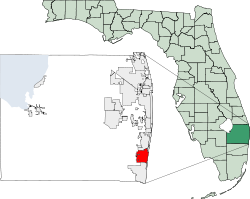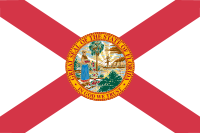Delray Beach, Florida
| Delray Beach | |
 |
|
| Coordinates: | |
| Country | |
|---|---|
| State | |
| County | Palm Beach |
| Incorporated (city) | 1911 |
| Government | |
| - Type | Commission-Manager |
| - Mayor | Rita Ellis |
| - City Manager | David T. Harden |
| Area [1] | |
| - Total | 15.89 sq mi (41.2 km²) |
| - Land | 15.37 sq mi (39.8 km²) |
| - Water | .53 sq mi (1.4 km²) |
| Elevation [2] | 9 ft (5 m) |
| Population (2006 est.)[3] | |
| - Total | 64,757 |
| - Density | 3,905.6/sq mi (1,507.9/km²) |
| Time zone | Eastern (EST) (UTC-5) |
| - Summer (DST) | EDT (UTC-4) |
| Zip Code | 33444-33448, 33482-33484 |
| Area code(s) | 561 |
| FIPS code | 12-17100[4] |
| GNIS feature ID | 0281485[5] |
| Website: http://www.mydelraybeach.com | |
Delray Beach is a city in Palm Beach County, Florida, USA. As of the 2000 census, the city had a total population of 60,020. As of 2004, the population estimated by the U.S. Census Bureau is 64,150.[6]
Contents |
History
The Early Years
The history of Delray Beach effectively begins with the construction of the Orange Grove House of Refuge in 1876. The house derived its name from the grove of mature sour orange and other tropical fruit trees found at the site chosen for the house of refuge, but no record or evidence of who planted the trees has survived. Indians presumably lived or passed through the area at various times, and hunters, trappers, and run-away slaves may also have lived or passed through the area in the 18th and 19th Centuries, but there is no record or evidence of them.
Settlement began around 1884, when Blacks from the Panhandle of Florida bought land a little inland from the Orange Grove House of Refuge and began farming. By 1894 the African-American community was large enough to establish the first school in the area.
In 1894 William Seelye "Steel Cut" Linton, postmaster of Saginaw, Michigan, bought a tract of land just west of the Orange Grove House of Refuge, and began selling plots in what he hoped would become a farming community. Initially, this community was named after Linton. In 1896 Henry Flagler extended his Florida East Coast Railroad south from West Palm Beach to Miami, with a station at Linton.
The Linton settlers began to achieve success with truck farming of winter vegetables for the northern market. A hard freeze in 1898 was a setback, and many of the settlers left, including William Linton. Partly in an attempt to change the community's luck, or leave behind a bad reputation, the settlement's name was changed in 1901 to Delray, after the Detroit neighborhood of Delray ("Delray" being the anglicized spelling of "Del Rey," which is Spanish for "of the king", which in turn, the Detroit neighborhood was named after the Mexican-American War's Battle of Molino del Rey).
By 1910, Delray had a population of 250. In 1911 Delray was chartered by the State of Florida as an incorporated town. In the same year pineapple and tomato canning plants were built in Delray. Pineapples became the primary crop of the area. This is reflected in the name of the present day Pineapple Grove neighborhood near downtown Delray Beach. By 1920 Delray's population had reached 1,051.
In the 1920s drainage of the Everglades west of Delray lowered the water table, making it harder to grow pineapples, while the extension of the Florida East Coast Railway to Key West resulted in competition from Cuban pineapples for the markets of the northern United States.
The Florida land boom of the 1920s brought renewed prosperity to Delray. Tourism and real estate speculation became important parts of the local economy. Delray issued bonds to raise money to install water and sewer lines, paved streets, and sidewalks. Several hotels were built. At that time Delray was the largest town on the east coast of Florida between West Palm Beach and Fort Lauderdale. The collapse of the land boom in 1926 left Delray saddled with high bond debts, and greatly reduced income from property taxes.
Delray was separated from the Atlantic Ocean beach by the Florida East Coast Canal (now part of the Intracoastal Waterway). In 1923 the area between the canal and the ocean was incorporated as Delray Beach. In 1927 Delray and Delray Beach merged into one town named Delray Beach.
Recent years
In recent years, Downtown Delray, located in the eastern part of the city, along Atlantic Avenue, east of I-95 and stretching to the beach, has undergone a large scale renovation. This area is now home to several upscale restaurants and several different assorted shops. Major driving factors in this renovation have been the business brought to the area by the Delray Beach Tennis Center, which has hosted several major international tennis events such as the April 2005 Fed Cup (USA vs. Belgium), the April 2004 Davis Cup (USA vs. Sweden), the Millennium ITC (ATP Event), and the Chris Evert / Bank of America Pro Celebrity. Concurrent with the new construction of the Tennis Center, several local historic landmark structures were renovated during the last decade of the 20th century. These include Old School Square, formerly Delray Elementary School and Delray High School, since turned into a thriving cultural center; and the Colony Hotel. Old School Square comprises the Crest Theatre, a venue for the performing arts, in the former High School building; the 1925 Gymnasium, restored to maintain its appearance, which has since become a popular venue for local events such as wedding receptions and dances; the Cornell Museum of Art and History, built in the restored Elementary School; and a recently constructed outdoor entertainment pavilion, which serves as a venue for musical performances and has also been used for events such as political rallies. More recently, the historic home of teacher/principal Solomon D. Spady was renovated and turned into the Spady Cultural Heritage Museum. The Spady Museum houses a black archives and hosts exhibits and programs designed to recognize the efforts of blacks who were instrumental in shaping Delray Beach and Palm Beach County.[7] As of 2007 the museum is being expanded with the renovation of a 1935 cottage as a Kid's Cultural Clubhouse, and the construction of a 50-seat amphitheater named for C. Spencer Pompey, a pioneer black educator.[8]
Atlantic Community High School was rebuilt in 2005 on a different site from the previous school, a plan which was met with much contention.[9][10]
Other notable recent Delray Beach projects are:
- Expansion of the South County Courthouse, which has more than doubled in size and will potentially hold jury trials in the future.
- New Delray Beach Public Library building, which is adjacent to the South County Courthouse and also share a high-capacity parking garage facility.
The current mayor of Delray Beach is Rita Ellis.[11]
Delray Beach is known as the drug addiction recovery capital of the United States and has the country’s largest recovery community and relative number of halfway houses.[3]
Geography
Delray Beach is located at (26.459101, -80.083038).[12] It lies directly north of Boca Raton, Florida and directly south of Boynton Beach, Florida. According to the United States Census Bureau, the city has a total area of 15.9 mi² (41.2 km²), of which 15.4 square miles (40 km2) is land and .53 square miles (1 km2) is water (3.34%).
Demographics
As of the census[4] of 2000, there were 60,020 people, 26,787 households, and 15,081 families residing in the city. The population density was 3,905.6/mi² (1,507.7/km²). There were 31,702 housing units at an average density of 2,062.9/mi² (796.4/km²). The racial makeup of the city was 66.49% White (61.8% were Non-Hispanic White,)[13] 26.63% African American, 0.17% Native American, 1.08% Asian, 0.08% Pacific Islander, 1.55% from other races, and 3.99% from two or more races. Hispanic or Latino of any race were 6.97% of the population.
There were 26,787 households out of which 18.9% had children under the age of 18 living with them, 42.4% were married couples living together, 10.2% had a female householder with no husband present, and 43.7% were non-families. 35.3% of all households were made up of individuals and 18.3% had someone living alone who was 65 years of age or older. The average household size was 2.22 and the average family size was 2.87.
In the city the population was spread out with 18.2% under the age of 18, 6.3% from 18 to 24, 27.1% from 25 to 44, 22.4% from 45 to 64, and 25.9% who were 65 years of age or older. The median age was 44 years. For every 100 females there were 91.2 males. For every 100 females age 18 and over, there were 88.0 males.
The median income for a household in the city was $43,371, and the median income for a family was $51,195. Males had a median income of $33,699 versus $28,469 for females. The per capita income for the city was $29,350. About 8.2% of families and 11.8% of the population were below the poverty line, including 17.6% of those under age 18 and 7.8% of those age 65 or over.
As of 2000, speakers of English as a first language accounted for 75.44% of all residents, while French Creole accounted for 11.73%, Spanish consisted of 7.02%, French was at 1.87%, Italian at 0.88%, and German made up 0.75% of the population.[14]
As of 2000, Delray Beach had the sixteenth highest percentage of Haitian residents in the US, with 10.50% of the population.[15]
Sister cities
Delray Beach has two sister cities, as designated by Sister Cities International:[16]
 Miyazu, Kyoto, Japan - Miyazu was the birthplace of George Morikami, for whom Morikami Park and the Morikami Museum and Japanese Gardens is named.
Miyazu, Kyoto, Japan - Miyazu was the birthplace of George Morikami, for whom Morikami Park and the Morikami Museum and Japanese Gardens is named. Moshi, Tanzania
Moshi, Tanzania
Downtown
Downtown Delray Beach is a retail, cultural, and residential hub. The area offers a multitude of upscale restaurants, retail, nightclubs, and art galleries. The city has a distinct pedestrian friendly atmosphere, which is aided by the prevalence of parallel parking. In addition, there are many free municipal parking lots and garages[4]
The Delray Affair, a three day long art and street fair, is hosted in Downtown Delray annually.
Location
In earlier years downtown Delray was centered along Atlantic Avenue as far west as Swinton Avenue and as far east as the intracoastal waterway. Downtown is expanding very rapidly, however. Downtown Delray now extends as far west as I-95 and as far east as the Atlantic Ocean; The north-south boundaries extend several blocks north and south of Atlantic Avenue.
North of Atlantic Avenue is the Pineapple Grove district of Downtown Delray. A wide array of art galleries can be found in this neighborhood, as well as many new urban residential townhomes.
Notable landmarks and buildings
- The Colony Hotel, built in 1926, is a "Delray Beach Historic Landmark" [17]
- Old School Square
- Delray Beach Tennis Center, Tennis stadium capable of seating 8,200 spectators
Recent development
Downtown Delray has grown tremendously in recent years and is in the midst of a building boom. Many new mixed-use development projects are currently under construction in the areas immediately north and south of Atlantic Avenue. To accommodate the anticipated growth the city has also begun construction on several new municipal parking garages. Government officials have made it even easier to request information or lodge a complaint with the City of Delray Beach. Through establishing a dedicated phone line and instituting the QAlert citizen service management software online, Delray Beach residents can simply visit www.mydelraybeach.com or call (561) 243-7012.
Notable people born in Delray Beach
- Mike Rumph, current NFL free safety for the Washington Redskins.
Notable residents
- Rod MacDonald, singer-songwriter-guitarist.
Transportation
- Delray Beach (Tri-Rail station)
Points of interest
- American Orchid Society Visitor Center and Botanical Garden
- Morikami Museum and Japanese Gardens
- Roji-en Japanese Gardens
- Delray Beach Public Library
- Cason Cottage
- Old School Square
- Delray Tennis Center
- Spady Museum[5]
- South County Courthouse
- Wakodahatchee Wetlands[6]
References
- ↑ "Florida by place Population, Housing Units, Area and Density:2000". US Census Bureau. Retrieved on 2007-07-23.
- ↑ "Delray Beach, US Profile". Falling Rain Genomics. Retrieved on 2007-08-06.
- ↑ "Annual Estimates of the population for the Incorporated Places of Florida" (XLS). US Census Bureau. Retrieved on 2007-08-06.
- ↑ 4.0 4.1 "American FactFinder". United States Census Bureau. Retrieved on 2008-01-31.
- ↑ "US Board on Geographic Names". United States Geological Survey (2007-10-25). Retrieved on 2008-01-31.
- ↑ http://www.census.gov/popest/cities/tables/SUB-EST2004-04-12.xls
- ↑ "Exhibit explores America’s first free black community". Broward Times. July 5, 2007. Found at [1] URL retrieved July 5, 2007
- ↑ Slire, Erika. (2007) "Spady Cultural Heritage Museum in Delray Beach adds facilities". South Florida Sun-Sentinel. July 15, 2007. P. PC-1. Also at [2]
- ↑ City of Delray Beach FAQ on relocation of Atlantic High - URL retrieved December 10, 2006
- ↑ Palm Beach Post editorial on moving the school - URL retrieved December 10, 2006
- ↑ "Meet Our Leaders". City Of Delray Beach. Retrieved on 2007-04-04.
- ↑ "US Gazetteer files: 2000 and 1990". United States Census Bureau (2005-05-03). Retrieved on 2008-01-31.
- ↑ "Demographics of Delray Beach, FL". MuniNetGuide.com. Retrieved on 2007-12-03.
- ↑ "MLA Data Center Results for Delray Beach, Florida". Modern Language Association. Retrieved on 2007-12-03.
- ↑ "Ancestry Map of Haitian Communities". Epodunk.com. Retrieved on 2007-12-03.
- ↑ "Online Directory: Floruda, USA". Sister Cities International. Retrieved on 2007-08-06.
- ↑ About the Colony Hotel
Sources
- Cecil W. and Margoann Farrar (1974). Incomparable Delray Beach - Its Early Life and Lore. Star Publishing Company, Inc., Boynton Beach, Florida.
- Sandy Simon (1999). Remembering: A History of Florida's South Palm Beach County 1894-1998. The Cedars Group, Delray Beach, Florida. ISBN 0-9669625-0-8.
- "Old School Square Cultural Arts Center – Creatively Blending Past and Present in Downtown Delray Beach"
- Spady Museum, Connecting Culture and Community
External links
- City of Delray Beach
- Greater Delray Beach Chamber of Commerce
- Downtown Delray Beach
- Morikami Museum and Japanese Gardens
- Delray Beach Public Library Website
- Delray Beach, Florida is at coordinates
|
|||||||||||||||||||||||
|
||||||||||||||||||||||||||
|

